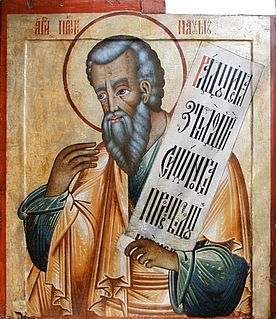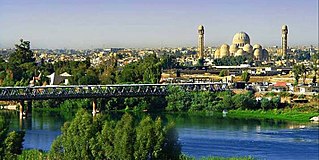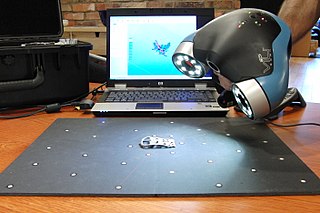
Nineveh was an ancient Assyrian city of Upper Mesopotamia, located on the outskirts of Mosul in modern-day northern Iraq. It is located on the eastern bank of the Tigris River and was the capital and largest city of the Neo-Assyrian Empire, as well as the largest city in the world for several decades. Today, it is a common name for the half of Mosul that lies on the eastern bank of the Tigris, and the country's Nineveh Governorate takes its name from it.

Nahum was a minor prophet whose prophecy is recorded in the Tanakh, also called the Hebrew Bible and The Old Testament. His book comes in chronological order between Micah and Habakkuk in the Bible. He wrote about the end of the Assyrian Empire, and its capital city, Nineveh, in a vivid poetic style.

Mosul is a major city in northern Iraq, serving as the capital of Nineveh Governorate. The city is considered the second largest city in Iraq in terms of population and area after the capital Baghdad, with a population of over 3.7 million. Mosul is approximately 400 km (250 mi) north of Baghdad on the Tigris river. The Mosul metropolitan area has grown from the old city on the western side to encompass substantial areas on both the "Left Bank" and the "Right Bank", as locals call the two riverbanks. Mosul encloses the ruins of the ancient Assyrian city of Nineveh on its east side.

Nineveh Governorate, to be better called Ninawa Governorate, is a governorate in northern Iraq. It has an area of 37,323 km2 (14,410 sq mi) and an estimated population of 2,453,000 people as of 2003. Its largest city and provincial capital is Mosul, which lies across the Tigris river from the ruins of ancient Nineveh. Before 1976, it was called Mosul Province and included the present-day Dohuk Governorate. The second largest city is Tal Afar, which had an almost exclusively Turkmen population.

A monument is a type of structure that was explicitly created to commemorate a person or event, or which has become relevant to a social group as a part of their remembrance of historic times or cultural heritage, due to its artistic, historical, political, technical or architectural importance. Some of the first monuments were dolmens or menhirs, megalithic constructions built for religious or funerary purposes. Examples of monuments include statues, (war) memorials, historical buildings, archaeological sites, and cultural assets. If there is a public interest in its preservation, a monument can for example be listed as a UNESCO World Heritage Site.

Chavín de Huántar is an archaeological site in Peru, containing ruins and artifacts constructed as early as 1200 BC, and occupied until around 400–500 BCE by the Chavín, a major pre-Inca culture. The site is located in the Ancash Region, 434 kilometers (270 mi) north of Lima, at an elevation of 3,180 meters (10,430 ft), east of the Cordillera Blanca at the start of the Conchucos Valley.

3D scanning is the process of analyzing a real-world object or environment to collect data on its shape and possibly its appearance. The collected data can then be used to construct digital 3D models.

A hypogeum or hypogaeum is an underground temple or tomb.

Nineveh Plains is a region in Nineveh Governorate in Iraq, to the north and east of the city Mosul. Control over the region is contested between Iraqi security forces, KRG security forces, Assyrian security forces, Babylon Brigade and the Shabak Militia.

Ain Sifni, also known as Shekhan, is a town and subdistrict in Nineveh Governorate, Iraq. It is located in the Shekhan District in the Nineveh Plains.

Donny George Youkhanna was an Iraqi-Assyrian archaeologist, anthropologist, author, curator, and scholar, and a visiting professor at Stony Brook University in New York.

The Zamani Project is part of the African Cultural Heritage Sites and Landscapes Database. Zamani is a research group at the University of Cape Town, which acquires, models, presents and manages spatial and other data from cultural heritage sites. The present focus of the Zamani project is Africa, with the principal objective of developing “The African Cultural Heritage Sites and Landscapes Database”. Zamani comes from the Swahili phrase “Hapo zamani za kale” which means “Once upon a time”, and can be used to mean 'the past'. The word is derived from Arabic root for temporal vocabulary, ‘Zaman,’ and appears in several languages around the world.
Kasubi is a hill in Kampala, Uganda's capital and largest city.

The Kasubi Tombs in Kampala, Uganda, is the site of the burial grounds for four kabakas and other members of the Baganda royal family. As a result, the site remains an important spiritual and political site for the Ganda people, as well as an important example of traditional architecture. It became a UNESCO World Heritage Site in December 2001, when it was described as "one of the most remarkable buildings using purely vegetal materials in the entire region of sub-Saharan Africa".
The Scottish Ten was a five-year project, initiated in 2009, funded by the Scottish Government. It used technology to create accurate digital models of the country's five World Heritage Sites and five other UNESCO World Heritage Sites elsewhere in the world.
Deliberate destruction and theft of cultural heritage has been conducted by the Islamic State of Iraq and Syria since 2014 in Iraq, Syria, and to a lesser extent in Libya. The destruction targets various places of worship under ISIL control and ancient historical artifacts. In Iraq, between the fall of Mosul in June 2014 and February 2015, ISIS had plundered and destroyed at least 28 historical religious buildings. Valuable items from some buildings were looted in order to smuggle and sell them to foreigners to finance the running of the Islamic State. By March 2019, ISIS had lost most of its territory in the Middle East.
Digital heritage is the use of digital media in the service of understanding and preserving cultural or natural heritage.

Tourism in Iraq refers to tourism in the Western Asian country Iraq. Iraq was one of the main destinations for many years, however it changed dramatically due to conflicts. The tourism in Iraq has faced many challenges, however, in recent years there has been improvements. The capital city Baghdad is the second largest city in the Arab world and the 4th largest in the Middle East. Iraq has several World Heritage Sites, dating back to ancient Mesopotamia, most notably Babylon Iraq. Iraq is considered to be a potential location for ecotourism. Erbil was chosen as "Arab Tourism Capital" in 2014 by the Arab Tourism Committee.
Artec 3D is a developer and manufacturer of 3D scanning hardware and software. The company is headquartered in Luxembourg, with offices also in the United States, China (Shanghai) and Montenegro (Bar). Artec 3D's products and services are used in various industries, including engineering, healthcare, media and design, entertainment, education, fashion and historic preservation. In 2013, Artec 3D launched an automated full-body 3D scanning system, Shapify.me, that creates 3D portraits called “Shapies.”















